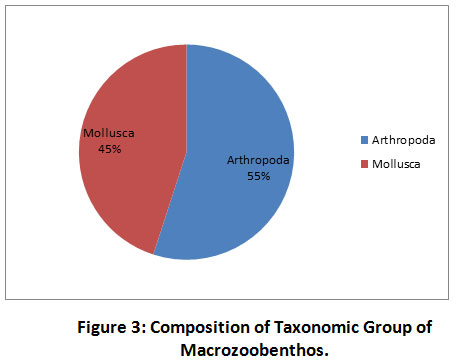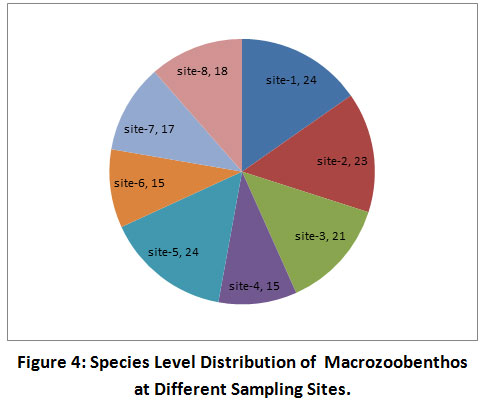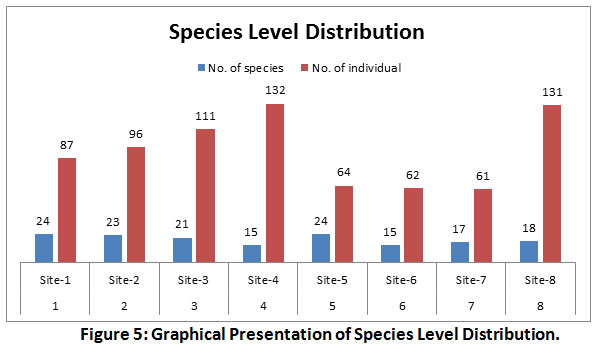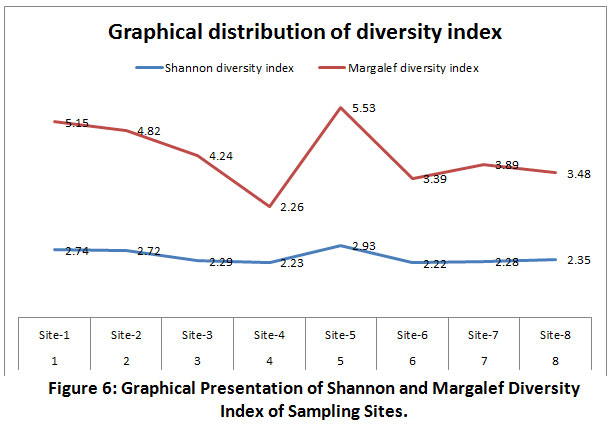A Study on Species distribution and Diversity of Macro-Fauna of River Tawa - A Tributary of River Narmada in Madhya Pradesh, India
Corresponding author Email: charuzoology05@gmail.com
DOI: http://dx.doi.org/10.12944/CWE.16.1.27
Copy the following to cite this article:
Tiwari C, Vyas V, Sharma M. A Study on Species distribution and Diversity of Macro-Fauna of River Tawa - A Tributary of River Narmada in Madhya Pradesh, India. Curr World Environ 2021;16(1). DOI:http://dx.doi.org/10.12944/CWE.16.1.27
Copy the following to cite this URL:
Tiwari C, Vyas V, Sharma M. A Study on Species distribution and Diversity of Macro-Fauna of River Tawa - A Tributary of River Narmada in Madhya Pradesh, India. Curr World Environ 2021;16(1). Available From : https://bit.ly/2Z8cqL5
Download article (pdf) Citation Manager Publish History
Select type of program for download
| Endnote EndNote format (Mac & Win) | |
| Reference Manager Ris format (Win only) | |
| Procite Ris format (Win only) | |
| Medlars Format | |
| RefWorks Format RefWorks format (Mac & Win) | |
| BibTex Format BibTex format (Mac & Win) |
Article Publishing History
| Received: | 16-07-2020 |
|---|---|
| Accepted: | 10-02-2021 |
| Reviewed by: | 
 Y. Vasudeva Rao
Y. Vasudeva Rao
|
| Second Review by: |

 Manoj Kumar
Manoj Kumar
|
| Final Approval by: | Dr. Hiren B. Soni |
Introduction
River ecosystems are most important lotic fresh water habitats for many aquatic animals and benthic animals are one of these animal. Benthic animals are generally found in both of fresh water habitats i.e. – lotic habitats and lentic habitats. Benthos spends their whole life in bottom of aquatic ecosystem because of their feeding nature. Basically they are detritus feeders and divided in to two types – microzoobenthos and macrozoobenthos. Macro benthos are those animals which can be seen with naked eyes. Their diversity and distribution are good indicators of water quality of an ecosystem that’s why they are known as bioindicators. In the present investigation diversity and distribution of Macroinvertebrates were recorded for the period of two years from July 2017 to June 2019. The study was focused on two main phyla of macrozoobenthos community of arthropoda and mollusca. Macrozoobenthos show sessile and sedentary behavior .Aquatic organisms are common indicator of aquatic environmental conditions.1 Macrozoobenthic fauna serve as a biological indicator of aquatic ecosystem.2 Physicochemical quality of water is the factors that influence species composition of a water body.3 Macrobenthos are good source of fish food and their food chain.4 They are Ecological engineers of ecosystems.5 Fresh water ecosystem was the conservation priority during International decade Action 6 and in the present time also. Periodical bioassessment of taxonomic diversity of aquatic ecosystem play an important role for nature and ecological protection. Different measures are used in bioassessment for fresh water.7 Macrozoobenthos due to their special characteristics are indicator of the water quality of an aquatic ecosystem.8,9 The abundance of macrozoobenthos are depending on its surrounding environment.2 composition of benthic community is directly related to water quality10 .The present research was aimed to study the distribution of benthic macro fauna of Tawa river.
Material and Methods
Study Area
Tawa River is one of the major tributaries of Narmada in the central India.The Tawa originates from Satpura hills of Betul district and flows towards Hoshangabad District of (Madhya Pradesh).The Tawa joins to Narmada river at Bandrabhan village of Hoshangabad. The preserve forest BORI is situated along the Tawa. Bori sanctuary of the preserve forest is very famous part of Biosphere of Panchmarhi of Hoshangabad district.
 |
Figure 1: Map Showing Position of Tawa River. Click here to view Figure |
 |
Figure 2: Map Showing Catchment Area of River – Tawa. Click here to view Figure |
Study Sites
Total 8 sites were identified for the research. Their geographical positions are shown in the Table 1. These sites arranged from upstream to downstream and joins to Narmada in Bandrabhan village at district Hoshangabad.
Table 1: Position of Sampling Stations.
|
Sampling station |
Name of sites |
Latitude |
Longitude |
|
S1 |
Sarni (power plant area) |
22.05068 |
78.1300 |
|
S2 |
Ghoradondri (banspur) |
22.1610 |
77.996 |
|
S3 |
Bhoura (khapa) |
22.2620 |
77.927 |
|
S4 |
Ranipur(dam area) |
22.5747 |
77.98004 |
|
S5 |
Maharghat |
22.684 |
77.831 |
|
S6 |
Babai bridge |
22.7104 |
77.83144 |
|
S7 |
Raipur |
22.71785 |
77.7254 |
|
S8 |
Bandrabhan (Tawa-Narmada confluence point) |
22.7441 |
77.7369 |
Protocoll
Selected sites were visited periodically to gather samples of benthic macro-fauna. To collect samples, various types of gears like surber sampler, D-net sampler, kick net sampler, and grab sampler etc. were used according to river bed of the sites. 0.5 to 0.6 micron mesh sized sieve were used to collect benthic macro fauna. Separated fauna were washed carefully and stored in labeled plastic bottles. 4% formalin were used for benthos preservation. Collected animals were identified upto the species level. Microscope and hand lens were used to observe detailed features of the animals.
Diversity and Richness Index
Collected samples were recorded in a manner of tabulation chart. After the collection of data, statistical analysis was done. In the present paper two important diversity index were analysed.
Diversity Index of Shannon
Shannon index is very common index which is used for diversity calculation of a habitat.11 The index value ranges between 0.0 and 5.00.
Table 3: Index Value and Diversity of Shannon Index.
|
Index value |
Diversity |
|
1.5 to 3.5 |
Common |
|
3.6 to 4.5 |
Rich |
|
4.5 to 5.0 |
Very rich |
H’= ∑ [(ni / N)*(ln ni / N)]
H’= Shannon Diversity Index
ni = number of individuals belonging to i species
N = Total number of individuals of all species
Richness Index of Margalef
The margalef index formula is used to calculate richness of species.12 This index shows richness of species in a habitat.r
d = (S -1) / ln N
d = Margalef Diversity Index
S = Total number of species
N = Total number of individuals
Result and Discussion
During the study, total 48 taxa of macrozoobenthos belonging to phylum Mollusca and Arthropoda were noted form eight sampling station of the study area. Out of these 48 taxa, 17 taxa of class Gastropoda represented by two orders Megastropoda and Hygrophila with 4 and 1 families respectively. Class Bivalvia was represented by three orders with four families Amblemidae, Unionidae, Corbiculidae and Lymnaeidae. Phylum Arthropoda has been recorded with two classes Insecta and Malacostraca. Class Insecta were represented by 6 orders and 17 families with 25 taxa while class Malacostraca represented by one order with a family. Class Insecta of phylum Arthropoda and class Gastropoda of phylum Mollusca were main representatives of macrozoobenthos of the river. Similar observations were recorded at Ganjal River, Ken River and Streams of Yedigoller National Park 14, 15, 16. Bellamya bengalensis of mollusca is a dominant species and found at all eight sampling stations and Total 41 individuals were collected. More than 20 taxa of phylum arthropoda and mollusca were recorded from four sampling sites S-1, S-2, S-3, and S-5. Maximum taxa varieties were noted from site1 and 5. Lowest number of taxa was observed from site 4 and 6. Bellamya bengalensis (family-Viviparidae) and Brotia costula (family-Thiaridae) of phylum mollusca were recorded from all the sampling stations. Phylum Arthropoda are dominant in position than Mollusca. Dominancy of phylum arthropoda in the river ecosystem was reported by Vyas, et.al. ,Sharma, et.al. and Khan 17, 18, 19. It may be due to favorable habitat conditions and food availability for Arthropods in the river. The finding of this study reports the current position of macrozoobenthos diversity of river Tawa.
 |
Figure 3: Composition of Taxonomic Group of Macrozoobenthos. Click here to view Figure |
 |
Figure 4: Species Level Distribution of Macrozoobenthos at Different Sampling Sites. Click here to view Figure |
Table 2: Diversity of Macrozoobenthos of Tawa River.
|
S.No. |
Taxa |
Sampling Stations |
|||||||
|
S1 |
S2 |
S3 |
S4 |
S5 |
S6 |
S7 |
S8 |
||
|
Phylum |
Mollusca |
||||||||
|
Class |
Gastropoda |
||||||||
|
Order |
Megastropoda |
||||||||
|
Family |
Viviparidae |
||||||||
|
1 |
Bellamya bengalensis |
+ |
+ |
+ |
+ |
+ |
+ |
+ |
+ |
|
2 |
Bellamya dissimilis |
- |
+ |
- |
+ |
+ |
+ |
+ |
+ |
|
3 |
Bellamya heliciformis |
- |
+ |
+ |
- |
- |
- |
+ |
+ |
|
4 |
Bellamya crassa |
- |
- |
+ |
- |
+ |
- |
- |
- |
|
5 |
Angulyagra microchaetophora |
- |
- |
+ |
- |
+ |
- |
+ |
- |
|
Family |
Thiaridae |
||||||||
|
6 |
Melanoides tuberculata crebra |
+ |
+ |
- |
+ |
+ |
+ |
- |
+ |
|
7 |
T.Melanoides tuberculata |
- |
+ |
+ |
+ |
+ |
- |
+ |
- |
|
8 |
Tarebia granifera |
- |
- |
+ |
- |
- |
+ |
- |
- |
|
9 |
Thiara (M.) tigrina raoi |
+ |
+ |
+ |
- |
+ |
- |
- |
+ |
|
10 |
Brotia costula |
+ |
+ |
+ |
+ |
+ |
+ |
+ |
+ |
|
11 |
Brotia costula juvenile |
+ |
+ |
+ |
- |
- |
+ |
- |
+ |
|
Family |
Bithyniidae |
||||||||
|
12 |
Gabbia travancorica |
- |
+ |
+ |
+ |
- |
- |
+ |
- |
|
13 |
Digoniostoma cerameopoma |
- |
- |
+ |
- |
- |
- |
- |
+ |
|
Family |
Pilidae |
||||||||
|
14 |
Pila globosa |
+ |
- |
- |
+ |
+ |
- |
- |
- |
|
Order |
Hygrophila |
||||||||
|
Family |
Planorbidae |
||||||||
|
15 |
Gyraulus velifer |
+ |
+ |
+ |
+ |
+ |
- |
- |
+ |
|
16 |
Gyraulus rotula |
+ |
- |
+ |
+ |
+ |
- |
- |
+ |
|
17 |
Indoplanorbis exustus |
- |
- |
- |
+ |
- |
- |
- |
- |
|
Class |
Bivalve |
||||||||
|
Order |
Trigoinoida |
||||||||
|
Family |
Amblemidae |
||||||||
|
18 |
Parreysia radiatula crispisulcata |
+ |
+ |
+ |
+ |
+ |
- |
- |
- |
|
19 |
Parreysia R. caerulea |
+ |
+ |
+ |
+ |
+ |
+ |
- |
+ |
|
Family |
Unionidae |
||||||||
|
20 |
Lamellidens narainporensis |
+ |
- |
- |
+ |
- |
+ |
- |
- |
|
Order |
Veneroida |
||||||||
|
Family |
Corbiculidae |
||||||||
|
21 |
Corbicula striatella |
+ |
+ |
- |
- |
+ |
+ |
+ |
- |
|
Order |
Basomatophora |
||||||||
|
Family |
Lymnaeidae |
||||||||
|
22 |
Lymnaea accuminata |
+ |
- |
+ |
+ |
+ |
+ |
+ |
+ |
|
Phylum |
Arthropoda |
||||||||
|
Class |
Insecta |
||||||||
|
Order |
Odonata |
||||||||
|
Family |
Gomphidae |
||||||||
|
23 |
Gomphus vastus |
- |
+ |
- |
- |
- |
- |
- |
- |
|
24 |
progomphus larva |
+ |
+ |
- |
- |
- |
- |
- |
- |
|
Family |
Aeshnidae |
||||||||
|
25 |
Anux sps. |
- |
+ |
- |
+ |
+ |
+ |
- |
- |
|
Lestidae |
|||||||||
|
26 |
Lestes sps |
- |
+ |
- |
- |
- |
- |
- |
- |
|
Family |
Libellulidae |
||||||||
|
27 |
Libellula luctuosa |
- |
+ |
- |
+ |
- |
- |
- |
- |
|
28 |
Libellula larva |
- |
- |
- |
- |
+ |
+ |
- |
- |
|
Family |
Cordulegastridae |
||||||||
|
29 |
Cordulegaster larva |
- |
- |
- |
- |
- |
- |
- |
+ |
|
Family |
Petalurdaei |
||||||||
|
30 |
Tachopteryx larva |
- |
- |
+ |
- |
- |
- |
- |
- |
|
Family |
Coenagrionidae |
||||||||
|
31 |
Enallagma sps. |
- |
- |
+ |
+ |
- |
- |
- |
- |
|
32 |
Enallagma larva |
- |
- |
+ |
+ |
+ |
- |
+ |
+ |
|
Family |
Macromiidae |
||||||||
|
33 |
Macromia larva |
+ |
- |
- |
- |
+ |
+ |
+ |
- |
|
Order |
Hemiptera |
||||||||
|
Family |
Nepidae |
||||||||
|
34 |
Ranatra sp. |
- |
+ |
+ |
- |
+ |
- |
+ |
- |
|
35 |
Nepa sp. |
- |
- |
+ |
+ |
+ |
- |
- |
+ |
|
Family |
Corixidae |
||||||||
|
36 |
Sigara sp. |
- |
+ |
- |
- |
- |
- |
- |
- |
|
Order |
Diptera |
||||||||
|
Family |
Culicidae |
||||||||
|
37 |
Culicinae larva |
- |
- |
- |
- |
- |
+ |
- |
- |
|
38 |
Culex pipiens larva |
- |
- |
- |
- |
- |
- |
+ |
- |
|
39 |
wyeomyia larva |
- |
- |
- |
+ |
- |
- |
- |
- |
|
Order |
Lepidoptera |
||||||||
|
Family |
Noctuidae |
||||||||
|
40 |
Bellura larva |
- |
+ |
+ |
- |
- |
- |
- |
- |
|
Order |
Ephemeroptera |
||||||||
|
Family |
Baetidae |
||||||||
|
41 |
callibaetis larva |
- |
- |
- |
+ |
- |
- |
+ |
- |
|
Family |
Siphlonuridae |
||||||||
|
42 |
ameletus larva |
- |
- |
+ |
+ |
- |
- |
- |
+ |
|
Family |
Behningiidae |
||||||||
|
43 |
Dolamia larva |
- |
- |
- |
- |
+ |
- |
- |
- |
|
Order |
Coleoptera |
||||||||
|
Family |
Carabidae |
||||||||
|
44 |
Omophron adult |
- |
- |
- |
+ |
- |
- |
+ |
+ |
|
45 |
Bembidion adult |
- |
- |
- |
+ |
- |
- |
- |
- |
|
Family |
Elmidae |
||||||||
|
46 |
Optioservus adult |
- |
- |
- |
- |
+ |
+ |
+ |
- |
|
47 |
Stenelmis adult |
- |
- |
+ |
- |
+ |
- |
- |
- |
|
Class |
Malacostraca |
||||||||
|
Order |
Decapoda |
||||||||
|
Family |
Palaemonidae |
||||||||
|
48 |
Palaemonetes sp. |
- |
- |
- |
- |
- |
- |
+ |
- |
In the study, Diversity index was from 2.22 to 2.93.The diversity value of site no. 5 was highest and lowest value of index was noted at site 6. Site1 and 2 shows similar diversity composition of species with index value 2.7. The Margalef index shows richness of species. The value margalef diversity index ranges between 5.53 to 2.26 and highest value was recorded at site 5.Taxonomic richness at sampling site 1 and 5 may be due to favorable habitats for macrozoobenthos. Similar conclusion was made by Vyas at Barna Stream13 and Mouri River by Khan et.al 20.
Table 3: Shannon and Margalef Index of the Sampling Sites.
|
Sampling Sites |
No. of Species |
No. of Individual |
Shannon Diversity Index |
Margalef Diversity Index |
|
Site-1 |
24 |
87 |
2.74 |
5.15 |
|
Site-2 |
23 |
96 |
2.72 |
4.82 |
|
Site-3 |
21 |
111 |
2.29 |
4.24 |
|
Site-4 |
15 |
132 |
2.23 |
2.26 |
|
Site-5 |
24 |
64 |
2.93 |
5.53 |
|
Site-6 |
15 |
62 |
2.22 |
3.39 |
|
Site-7 |
17 |
61 |
2.28 |
3.89 |
|
Site-8 |
18 |
131 |
2.35 |
3.48 |
 |
Figure 5: Graphical Presentation of Species Level Distribution. Click here to view Figure |
 |
Figure 6: Graphical Presentation of Shannon and Margalef Diversity Index of Sampling Sites. Click here to view Figure |
Conclusion
In the present study of macrozoobenthos diversity of Tawa river, dominant phylum was Arthropoda followed by Mollusca. The range of Shannon diversity index was lies between 2.93 to 2.22 which are indicating moderate pollution level in the sampling sites. Species diversity value in the range of 1.00 to 3.00 indicates moderate pollution in the water. Margalef diversity index value varied from 2.26 to 5.53 in the study and indicates low species richness. Road connectivity increased human activities in the study area. Moreover, Agriculture activities, dam, activity of power plant, over exploitation and human disturbance in the study area may be cause to change habitat structure and low of species richness.
Acknowledgement
The authors are thankful to the Department of zoology and aquaculture and Department of Bioscience, Barkatullah University, Bhopal, (M.P) India, for providing necessary facilities for study as well as laboratory analysis. I also thank to my co-workers who helped in all the field studies. I am grateful to my Guide and Co-Guide for their guidance.
Funding Source
The author(s) received no financial support for the research, authorship, and/or publication of this article.
Conflict of Interest
The authors do not have any conflict of interest.
Reference
- McLusky D.S, Elliot D. The esturine ecosystem: ecology, threats and management.3rd edn.Oxford University press,Oxford, 2006; 214pp.
- RAMP, Regional Aquatic Monitoring Program,benthos ramp online,RAMP Inc.s 2017.
- Boyd CE, Water quality in warm water fish ponds. Auburn university, Agriculture experiment station, Auburn,Alabama,USA. 1979; 9-44.
- Longhurst A.R. The food of the demersal fish of the west African estuary.j,Anim.Ecol. 1957; 26,369-378.
CrossRef - Asadujjaman M, Hossain MB, Shamsuddin M, Amin MA, Azam AKM. Occurrences and abundance of macrobenthos of Hatiya and Nijhum Dweep Islands,Bangladesh, middle east, journal of science and research.2012; 11(2):184-188.
- Dudgeon D.et.al. Fresh water biodiversity : Importance, Threats, Status, and Conservation challenges. Biological reviews, 2006; 81: 163-182.
CrossRef - Pawel Koperski, Reduced diversity and stability of chironomid assemblages.(chironomidae,diptera) as the effects of moderate stream degradation. journal of ecology, 2009;57: 125-138.
- Liebmann H. Die Bedeutung der mikroskopfschenuntersuchung fur die biologische wasseranalyse. Vom Wasser, 1942; 15,181-188.
- Gordon C.Hypersaline lagoons as conservation habitates: macroinvertebrates at muni lagoon,Ghana,` Biodivers,conserve. 2000;9(4),465-478.
CrossRef - Mehndi iqubal et.al. Diversity asnd abundance of macrobenthos in a subtropical estuary, Bangladesh.Research journal of Species, 2018; vol.19, 140-150pp.
- Shanon CE, WeaverW,:The mathematical theory of communication urbana :University of Illinois press,1948; 94-117.
- Margalef R.Information Y diversided especificated communicated the organism. Invest.pesg. 1956;3:99-106
- Vyas V. Bhawsar A.Benthic community structure in Barna stream network of Narmada river basin.international journal of environmental biology, 2013; 3(2): 57-63.
- Sharma.R,Kumar A. and Vyas V. diversity of macrozoobenthos in morand river-A tributary of Ganjal river in Narmada basin. International journal of advance fisheries and aquatic science. 2013;1(1):57-65.
- Nautiyal P, and Mishra AS .Variation in benthic macroinvertebrate fauna as indicator of land use in the Ken River, central india.journal of Threatened Taxa. 2013; 5(7):4096-4105.
CrossRef - Turkmen G,and Kazanci N. application of various biodiversity indices to benthic macroinvertebrate assemblages in streams of a nation park in Turkey. Review of hydrobiology. 2010;3(2):111-125.
- Vyas V, Bharose S,Yousuf S and Kumar A, .Distribution of macrozoobenthos in river Narmada near water intake point in india. journal of natural science and research, 2012 ;2(3):18-24
- Sharma R.Kumar A. and Vyas V. diversity of macrozoobenthos in Morand River-A tributary of Ganjal River in Narmada basin. International journal of advance fisheries and aquatic science. 2013; 1(1):57-65.
- .Ishaq F.Khan A. Diversity pattern of macrozoobenthos and their relation with qualitative characteristics of River Yamuna in Doon valley Uttarakhand. American Eurasian journal of toxicological science. 2013; 5(1); 20-29. ISSN 2050-2079.
- Khan A.N. Kamal D. Mahmud M.M. Rahman M.A. and Hossain M.A. Diversity, distribution and abundance of benthos in Mouri River Khulna Bangladesh. International journal of sustainable crop production. 2007; 2 (5); 19-23.
- Adoni A.D,Joshi G,Ghosh K,Chourasia S.K, Vaishya A.K, Yadav K, Verma H.G. Workbook on Limnology sagar,india. Pratibha publication, (1985).
- Ahmad bhat Najeeb, Wanganeo Ashwani, Raina Rajni, spatio-temporal variation of the zooplankton community in a tropical wetland (Bhoj Wetland),Bhopal,India. Journal of ecology and the natural environment,2014.
- Marie Anne Eurie Forio, Koen Lock, Eve Daphne Radam, Marlito Bande, Victor Asio, Peter L.M. Goethals. Assessment and analysis of ecological quality, macroinvertebrate communities and diversity in rivers of a multifunctional tropical island. Ecological indicators,2017.







